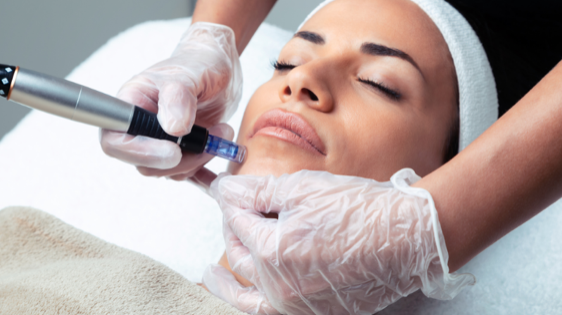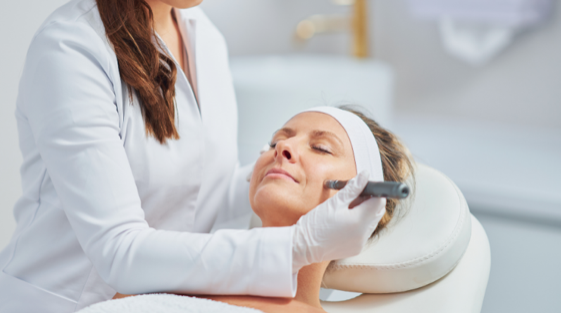Last Updated on February 14, 2025 by Ruby And The Wolf
Microneedling has become a popular skincare treatment, drawing interest from those looking to improve their skin’s texture and appearance. This minimally invasive procedure involves the use of tiny needles to create controlled micro-injuries on the skin’s surface. Doing so, encourages the skin to produce more collagen and elastin, leading to rejuvenation and healing of minor imperfections like acne scars, large pores, and wrinkles. Microneedling stands out as a compelling option for individuals seeking a boost to their skin’s vitality and a smoother complexion.
Many people are curious about the benefits of microneedling and how it compares to other skincare treatments. This interest is fueled by reports of improved skin health and appearance following sessions. Professional microneedling treatments are often performed by dermatologists or aestheticians, providing noticeable results, although there are also at-home dermaroller options available. By exploring microneedling’s potential, individuals can better understand if this treatment aligns with their skincare goals.
The treatment is considered safe for most skin types, with proper care and consultation, and it opens up possibilities for dealing with various skin concerns. While minor discomfort and redness may occur directly following a session, these are generally temporary. The advancements in microneedling technology and its ability to address skin issues have contributed to its growing popularity. Spa-goers and beauty enthusiasts continue to explore microneedling as part of their skincare regimen to achieve desired results and renewed skin confidence.
Understanding Microneedling and Its Benefits
Microneedling, often referred to as collagen induction therapy, is a popular skin treatment with a variety of benefits. It focuses on rejuvenating the skin by stimulating collagen production, improving texture, and addressing multiple skin concerns like scars and wrinkles.
Defining Microneedling
Microneedling involves the use of a tool covered with tiny needles to create controlled micro-injuries in the skin. This process triggers the body’s natural wound healing process, which results in increased collagen and elastin production.
The procedure is minimally invasive and can be performed on the face and other parts of the body. It is well-regarded for its ability to enhance skin texture and elasticity over time.
Addressed Skin Concerns
Microneedling is effective for a range of skin issues. It is commonly used to reduce acne scars, fine lines, and wrinkles by promoting new collagen formation. The treatment helps diminish the appearance of large pores and enhances overall skin tone.
Additionally, microneedling can aid in reducing hyperpigmentation and improving the penetration of skincare products. With regular sessions, individuals may notice more youthful and firm skin, making it a versatile choice for various skin rejuvenation needs.
The Science Behind Collagen Induction Therapy
Collagen Induction Therapy (CIT), commonly referred to as microneedling, involves creating controlled injuries to the skin to trigger a healing response. This process significantly enhances the production of collagen and elastin, integral proteins that play a role in maintaining skin’s firmness and elasticity.
Scientific Mechanism and Microneedling Process
Microneedling works through the use of sterilized needles to puncture the skin. These micro-injuries initiate a repair process. The body’s natural healing mechanisms step in, triggering increased blood flow to the area.
This blood flow brings essential nutrients and oxygen, essential for repairing and rejuvenation. The controlled punctures also facilitate better absorption of topical applications, enhancing their effectiveness.
Scientific studies underline that microneedling is effective because it meticulously balances injury with repair, stimulating processes that naturally rebuild and strengthen the skin. By targeting the epidermis and dermis, it reaches the optimal layers to instigate significant improvement.
Collagen and Elastin Production Boost
Collagen and elastin are crucial for skin structure and resilience. Microneedling directly promotes the production of these proteins. By initiating the natural wound repair process, it results in collagen remodeling, leading to improved skin texture.
Increased collagen production helps in reducing the appearance of fine lines, wrinkles, and acne scars. Meanwhile, elastin contributes to the skin’s suppleness, making it more resistant to sagging.
This approach not only rejuvenates the skin but also strengthens its structural integrity, making it thicker and more resistant to damage. Consequently, microneedling is valued for its ability to effectively revitalize the skin by harnessing and boosting the body’s innate regenerative capabilities.
What To Expect During a Microneedling Session
Microneedling, also known as collagen induction therapy, stimulates collagen and elastin production to rejuvenate the skin. During a microneedling session, clients can anticipate a procedural approach that emphasizes safety and effectiveness. Understanding the treatment process and the steps involved in consultation and recovery are crucial for achieving optimal results.
Consultations Are Essential For Best Results
Before the procedure, a thorough consultation is conducted to assess individual skin type and goals. Practitioners gather medical history details and discuss expectations, ensuring the treatment aligns with desired outcomes. Personalized assessments help tailor the approach to meet specific skin concerns such as scars or texture issues. ImageLab Med Spa offers expert guidance for customized microneedling treatments, making it a reliable choice for prospective clients.
Post-consultation, a clear plan outlining pre-treatment care and any necessary precautions is provided. This may include avoiding certain skincare products or direct sun exposure. After the session, insights into aftercare routines are given to support the skin’s healing process, focusing on strategies to nurture and protect the treated area.
Treatment Process for Microneedling Therapy
The microneedling session itself involves the use of a device equipped with fine needles. These needles create micro-channels in the skin, prompting the body’s natural healing mechanism to activate. This process enhances collagen and elastin levels, contributing to skin repair and a more youthful appearance.
During the session, the treatment area is cleansed to maintain a sterile environment. The practitioner adjusts needle depth to suit different facial zones and concerns, optimizing the procedure’s effectiveness. Clients might experience mild discomfort, likened to a pinprick sensation, but the treatment is generally well-tolerated.
Post-treatment, some redness and sensitivity are expected, typically subsiding within a few days. The skin begins to repair itself, ultimately revealing improved texture and tone. Following the practitioner’s aftercare advice is vital for minimizing downtime and maximizing results, as the skin continues to generate new, healthy cells over the following weeks.

Microneedling Results and Longevity
Microneedling is a popular skin treatment that can enhance texture and promote rejuvenation. This process involves creating micro-injuries in the skin, which stimulate collagen production. Understanding the improvements in skin texture and how long the results last can guide one’s maintenance routine and expectations.
Improved Skin Texture
Microneedling leads to enhanced skin texture by promoting collagen and elastin production. After treatment, individuals may observe smoother, more radiant skin. The procedure benefits those with issues like fine lines, acne scars, and uneven skin tone.
This improvement is often visible within a few days to weeks post-treatment. The skin’s surface appears rejuvenated, partly due to the natural healing process triggered by the micro-injuries. With repeated sessions, the cumulative effect can significantly boost overall skin appearance.
Result Longevity
The longevity of microneedling results depends on various factors, including age, skin type, and post-care. Generally, the effects of a single session can last several months; typical ranges are around 3 to 5 months. Regular maintenance, such as additional treatments, can help extend these benefits.
Traditional microneedling might necessitate sessions every 6 to 12 months, while radiofrequency-assisted methods could last 12 to 18 months. Adopting a good skincare routine and a healthy lifestyle further prolongs results. By doing so, individuals can maintain their rejuvenated appearance and maximize the investment in their skincare treatment.
Microneedling Frequently Asked Questions Section
Microneedling is a skin rejuvenation technique used for various dermatological benefits. It can address concerns such as scarring, fine lines, and hair regeneration. The process involves the use of tiny needles to create micro-injuries in the skin, which promotes collagen production. When considering this treatment, people often have questions regarding safety, costs, recovery time, potential risks, and the possibility of at-home procedures.
What are the potential benefits of undergoing microneedling?
Microneedling can improve skin texture and reduce the appearance of scars, fine lines, and enlarged pores. It may also help with pigmentation issues and stretch marks by stimulating collagen and elastin production. This minimally invasive procedure can result in healthier, younger-looking skin.
Can microneedling be safely performed at home, and if so, how?
Home microneedling devices are available, but they typically use shorter needles than professional treatments. It’s important to follow instructions carefully and maintain hygiene by sterilizing equipment before use. While home devices may provide mild improvements, professional treatments generally yield more significant results and are considered safer in terms of avoiding skin damage or infection.
What should one expect in terms of recovery and results after microneedling?
Recovery time for microneedling can vary from a few days to a week, with some redness and minor skin irritation. Results, like smoother skin and reduced scarring, often become visible after a few sessions. Many individuals notice a gradual improvement in skin quality as the production of collagen increases over time.
How much can one expect to pay for professional microneedling treatments?
The cost of professional microneedling treatments can range significantly, often between $200 to $700 per session, depending on the provider and location. Multiple sessions are typically recommended for optimal results, and pricing can sometimes include additional services, such as topical serums or aftercare products.
What are the known downsides or risks associated with microneedling?
Risks of microneedling may include temporary redness, swelling, and potential discomfort. There is also a risk of infection if the skin is not properly cleansed and the equipment is not sterilized. Rarely, patients may experience hyperpigmentation or prolonged irritation, especially with improper aftercare or an aggressive treatment approach.
How does microneedling contribute to hair regeneration?
Microneedling may stimulate hair growth by increasing blood supply and nutrient delivery to hair follicles. It promotes the production of growth factors important for hair health. Often used alongside topical treatments, microneedling can enhance their absorption and efficacy, potentially offering a complementary approach to hair loss treatments.

